喜屋武千恵 KYAN Chie
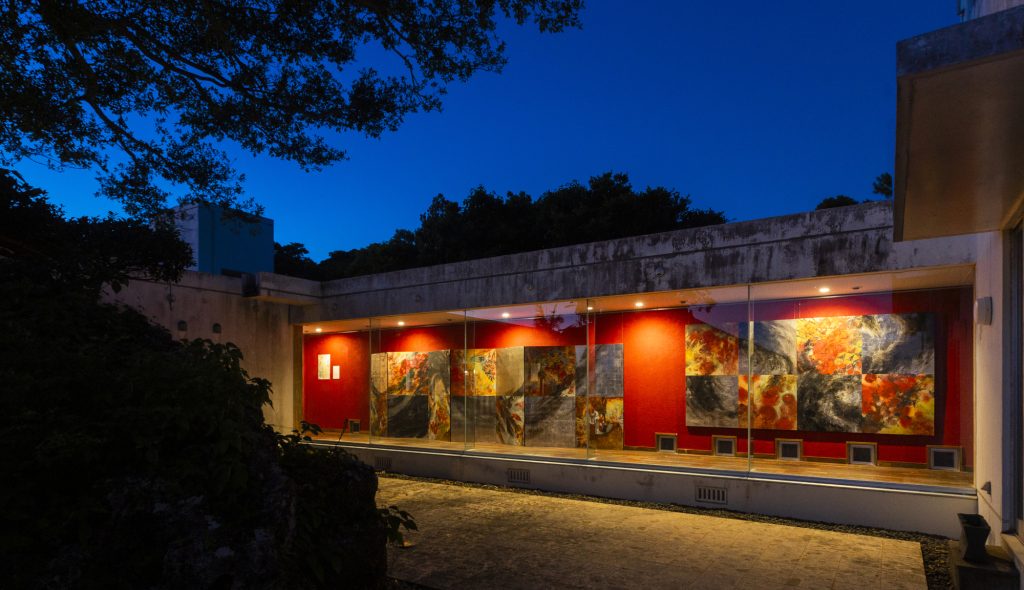
「素材と表現―膠がつなぐひととひと―」展の展示風景 2023年 キャンプタルガニーアーティスティックファーム、沖縄 撮影:高野 大
1.Left: Resonance, 2016, Natural pigment, Sumi ink, Glue, Gold and Silver leaf, Silver paint on Hemp paper, Getto paper and Mino paper 180.0×630.0㎝
Right: Resonance-Sublimation, 2022-2023, Natural pigment, Sumi ink, Glue, Gold and Silver leaf, Silver paint on Hemp paper, Getto paper and Mino paper 162.0×324.0㎝
Material and Expression-People connected by glue-, 2023, CAMP TALGANIE artistic farm, Okinawa, Photo by TAKANO Dai
喜屋武千恵
KYAN Chie
1969年沖縄県那覇市生まれ。沖縄に在住、活動。
《共鳴》について
沖縄の祈りの場である御嶽(ウタキ)、その何もない空間に身を置くとき、まるで子宮の中で、柔らかな羊水に包まれているような、何とも不思議な気持ちになる。
沖縄で生まれ育った私の周りには、日々の暮らしの中に常に祈りがあった。「目には映らない大切なもの」を可視化すること。縄文土器にも見られる「円環」「螺旋」などの自然の中に存在する形状を、沖縄の素材(赤土、琉球藍など)や天然顔料にこだわり創作している。それらは単なる物質ではなく、ここに生きたすべての命、記憶が溶け込んでいると考えるからだ。赤土は、読谷村の読谷飛行場跡地の赤土を採取し、使用している。読谷飛行場は、第二次世界大戦の際、日本軍が農地を強制的に接収して飛行場とし、敗戦後はアメリカ軍が使用を続け、住民の長年の抗議活動の末、2006年に全面返還された歴史を持つ。この赤土には、苛酷な現代史の記憶とともに、そこに生きる人々の平和を願う強い想いと行動で取り戻すことが出来たという、希望のエネルギーも浸み込んでいる。
矩形のパネルは、それぞれ独立した作品であり、展示する場と共鳴し再構成され、新たな表情をみせる。《共鳴》を発表した佐喜眞美術館は、普天間基地の一部を取り戻し建設された美術館で、芸術を通して平和の尊さを発信する「もの思う空間」である。
佐喜眞美術館の「もの思う空間」と作品《共鳴》と対峙する人との共鳴が広がっていくことを願い創作した。
モチーフとなっている蘇鉄(ソテツ)は、亜熱帯に生息する原始的な植物であり、沖縄にも多く自生している。飢饉の際は、幾度も人々の命を繋いできた。
私にとって蘇鉄は、20代の頃から繰り返し描いてきた特別な存在であり、朱色の種子を抱いた雌株は、我が子を慈しみ抱く母の姿と重なる。テーマにある「母性」は、性別も超えた、大地や海、地球という大きな意味での「母性」でもある。
《共鳴―昇華》について
《共鳴》は、母性、慈愛を内包し育み生みだすエネルギー。
《昇華》は、父性、開き解き放たれ、大きく上昇し拡がりゆくエネルギー。
受精卵が活発に細胞分裂を繰り返し増殖するように、2022年に発表した《共鳴》に、新たに2023年に創作した《昇華》を繋げて、一枚の作品《共鳴―昇華》として構成した。
葛飾北斎の怒涛図《女波―男波》に着想を得て創作した本作品は、陰陽の考えにあるように、生と死、女と男、相反するのではなく、ひとつに溶けあい大きく循環するものである。
沖縄(琉球)は、その長い歴史の中で政治的に今もなお翻弄され続けている。
そして、世界中でも同様に悲惨な現実は続いている。
私にとって、描くことは祈りそのものである。これからも、鎮魂と平和への祈りを捧げていきたい。
喜屋武 千恵
喜屋武千恵作品集『喜屋武千恵、母性-祈り-鎮魂』、2023年11月18日発行に掲載。
Born in Naha city, Okinawa 1965 and Lives and works in Okinawa.
Resonance
When I step into an utaki, an Okinawan place of prayer, even in that space where there is nearly nothing around, I feel a mysterious sensation in my womb, like something wrapped up in a tender amniotic fluid.
As someone born and raised on Okinawa, prayer was a part of my everyday life. Visualizing things that are important but that we cannot see with our eyes. I am fascinated by forms that exist in nature, like the circles and spirals that can also be seen on prehistoric Jōmon era pottery, as I create them using Okinawan materials (red clay, Ryukyu indigo, etc.) and natural pigments. These materials are not just mere physical matter. The lifeforce and memories of everything that has lived here are merged into them. The red clay I use here is earth I collected at the former Yomitan Airfield in Yomitan village. The airfield has a long history, of the Japanese military forcibly seizing farmland to first construct the airfield during World War II, the American military continuing to use the airfield after the war, and of many years of active protests by residents before, finally, the entire area was returned in 2006. The memory of this harsh history, along with the hopeful energy of the people who lived there and whose thoughts and actions desiring peace brought about the return of the land, are embedded into this clay.
These rectangular panels are each independent works, but they resonate with the museum site and form a new composition, revealing a new appearance. The Sakima Art Museum which is presenting “Resonance” is built on a section of returned land from the Futenma Air Station. It is a space for thoughts, broadcasting how precious peace is, through the arts.
I created this work in the hopes that it can broaden the resonances between the “space for thoughts” of the Sakima Art Museum, the artwork “Resonance,” and the people who contemplate them together.
The sago palm which is the motif of this work is a primeval plant that thrives in sub-tropical areas, and can be found across Okinawa. In times of famine, it frequently became intertwined with the people’s lives.
The sago palm has special meaning for me, as I painted it numerous times in my 20s. The female plant, covered in vermillion seeds, overlaps with the image of a mother tenderly holding her child. The theme of motherhood here is one of a continent, an ocean, a world as mother, holding great meaning and transcending gender.
Resonance – Sublimation
“Resonance” is motherhood, an energy of wrapping something in affection, cultivating it, and giving birth to it.
“Sublimation” is fatherhood, an energy of opening up and letting go, of rising up and expanding.
Much like a fertilized egg undergoes cell division again and again and multiplies, I newly attached “Sublimation,” created in 2023, to “Resonance,” presented in 2022, creating a new single composition, “Resonance – Sublimation.”
Taking inspiration from Katsushika Hokusai’s image of surging waves “Masculine and Feminine Waves,” this work does not take life and death, man and woman, to be opposed to one another, but rather, like yin and yang, to meld together into a larger cycle. Okinawa (Ryukyu) is still today buffeted politically by the turbulent winds and waves of its long history.
Similar tragic realities continue around the world as well.
To me, painting is prayer. I will continue to pray for peace and for the repose of the souls of the departed.
KYAN Chie
Translated by: Travis SEIFMAN
Art Works by KYAN Chie , KYAN CHIE : Motherhood – Prayer – Requiem, November 18, 2023
喜屋武千恵についての新しい情報は、作家のHPやSNSをご覧ください。
Please refer to the following artist’s website and social media pages for new updates.
https://www.chie-kyan.com/
Instagram
Facebook
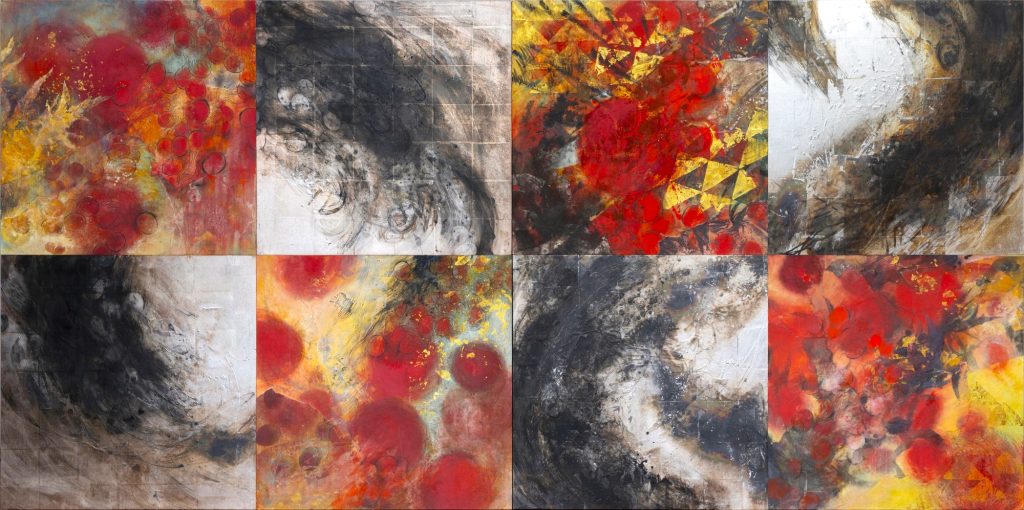 2.《共鳴―昇華》2022-2023年 天然顔料、墨、膠、金銀箔、銀泥、麻紙、月桃紙、美濃紙 162.0×324.0㎝
2.《共鳴―昇華》2022-2023年 天然顔料、墨、膠、金銀箔、銀泥、麻紙、月桃紙、美濃紙 162.0×324.0㎝
2. Resonance-Sublimation, 2022-2023, Natural pigment, Sumi ink, Glue, Gold and Silver leaf, Silver paint on Hemp paper, Getto paper and Mino paper 162.0×324.0㎝
赤土の記憶
荒井経(東京藝術大学教授)
沖縄県立芸術大学で日本画を専攻した喜屋武千恵は、手漉き紙や膠、岩絵具といった自然素材に魅力を感じて日本画を描き続けてきたが、近年では沖縄の地域性を象徴する素材を画材として用いるようになっている。喜屋武千恵は、「母性・祈り・鎮魂をテーマに、沖縄の素材(赤土、琉球藍など)や天然顔料にこだわり創作している。それらは単なる物質ではなく、ここに生きたすべての命、記憶が溶け込んでいると考えるからだ」と語る。私が特に注目したのは、喜屋武千恵が自ら採集し、精製した赤土を顔料として絵画の地塗りに使用していることである。沖縄は、日本の最南端に位置する列島で、19世紀末に日本に併合されるまでは清朝に朝貢する琉球王国であった。沖縄県という日本の一地域になった後には、第二次世界大戦の激戦地となり、日本が敗戦した1945以降は1972年に日本に返還されるまでアメリカ軍の統治を受けていた。喜屋武千恵は読谷飛行場跡地から赤土を採集している。読谷飛行場は、第二次世界大戦で窮地に陥った日本軍が農地を強制的に接収して飛行場としたもので、日本の敗戦後はアメリカ軍が使用を続け、住民らによる長年の抗議活動を経た2006年に全面返還された。読谷の赤土には、沖縄に暮らしてきた人々の長い歴史と、苛酷な現代史の記憶が浸み込んでいる。
自然からの採集物を素材とする表現は現代美術の一つの手法として既に確立されている。フェルトやラードを使ったヨセフ・ボイス(1921- 1986)の芸術思想が世界中の現代美術に多大な影響を与えたことは言うまでもない。同じくドイツ出身の芸術家であるヴォルフガング・ライプ(1950‐)が、自ら採集した大量の花粉や牛乳などを単純な形態として提示するインスタレーションも広く知られるところであり、そうした「材質」自体が持つ「意味」を用いた芸術表現は大きな潮流になっているが、喜屋武千恵の作品は、そうしたグローバルな現代美術の尺度によって評価できない点を有している。それは、「色彩」のために使われてきた岩絵具が持つ「色材」の特性から「材質」という造形要素が抽出され、材質の持つ「意味」を表現の一部にしていったという点である。そして何よりも重要なことは、彼女の作品や活動が、彼女が生活する沖縄社会の問題に動機付けられたものであり、その動機によって「材質」を採集し、表現をしているという点である。喜屋武千恵の作品においては、読谷の赤土が土地の記憶と現代社会とをつなぐ橋として機能しているのである。
荒井経 寄稿文「赤土の記憶」より 喜屋武千恵個展「RESONATE-共鳴-」ギャラリーアトス、沖縄 2022年
Memories held by the Red Clay
ARAI Kei, Professor, Tokyo University of the Arts
Kyan Chie, a specialist in Nihonga painting at the Okinawa Prefectural University of Arts, continues to paint Nihonga with a fascination with natural materials such as handmade paper, nikawa hide-glue, and mineral pigments. In recent years, however, she has increasingly come to use materials symbolizing the character of locality in Okinawa.
Kyan says “I use Okinawan materials (red clay, Ryukyu indigo, etc.) and natural pigments to create works with care, emerging from a fascination with themes of motherhood, prayer, and the spirits of the people of the past. These materials are not just mere physical matter. The lifeforce and memories of everything that has lived here are merged into them.” Something that catches my attention in particular is her use of red clay, which she collects and refines into paint herself, as the undercoat in her paintings.
A string of islands in the southernmost part of Japan, Okinawa was previously the independent Ryukyu Kingdom, a loyal tributary to the Qing Empire until the kingdom’s annexation by Japan in the late 19th century. After becoming part of Japan as “Okinawa prefecture,” the islands became the site of bloody battles in World War II, and then came under American Occupation from the time of Japan’s defeat in 1945 until their “reversion” to Japan in 1972.
Kyan collects red clay soil from the former site of the Yomitan Airfield. The site was first made into an airfield during World War II, when the Imperial Japanese Army, having fallen into a predicament, forcibly seized land from farmers to do so. After Japan’s defeat, the US military continued to use the airfield for many years until, finally, after many years of protest by local residents and others, the US returned the entirety of the site in 2006. The long history of the people of Okinawa, as well as the memories of this harsh, more recent, history, are embedded into the red earth of Yomitan
The use of materials collected from nature is a method already well-established in modern art. It goes without saying that the artistic thought of Joseph Beuys (1921-1986), who used felt and fat in his works, has had an enormous impact on modern art around the world. Installation pieces by the German artist Wolfgang Laib (b. 1950) straightforwardly displaying great volumes of pollen, milk, and other materials he gathered himself are also widely known. These sorts of artistic expressions using the meaning held by the character of materials themselves have become a powerful trend, but Kyan Chie’s artworks have elements that cannot be assessed by the standards of global contemporary art. The particular material qualities of the mineral pigments she uses for color are abstracted out as elements which express meaning held in the materials themselves. Most importantly, Kyan’s artworks and practice are motivated by the problems people face in the Okinawan society in which she lives, and it is from that motivation that she gathers materials and uses them in expression. Her works function as a bridge between the memory contained within the red earth of Yomitan, and contemporary society today.
Translated by: Travis SEIFMAN
contributed essay to KYAN Chie solo show, RESONATE-Kyomei-, Gallery ATOS, Okinawa, 2022
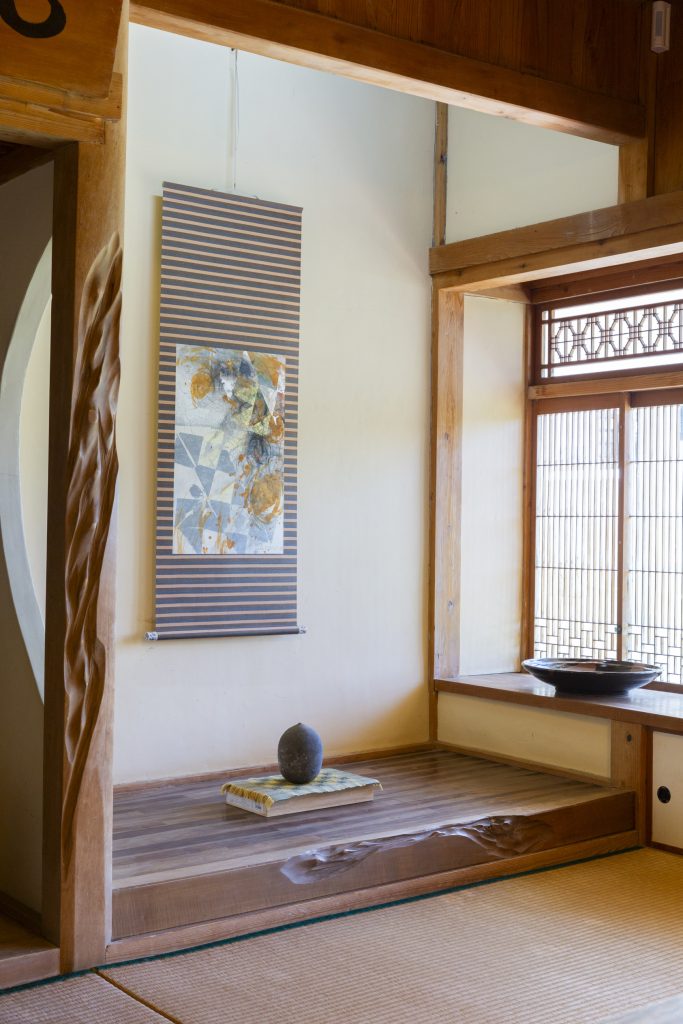
3.《ハベル №3》 2023年 天然顔料、墨、膠、金銀箔、薄美濃紙 65.0×48.0㎝
「素材と表現―膠がつなぐひととひと―」2023年 キャンプタルガニーアーティスティックファーム、沖縄 撮影:高野 大
*手前の陶の作品:タカエズトシコ《閉じたフォルム》 キャンプタルガニー常設作品
3. Habelu(Butterfly)No.3, 2023, Natural pigment, Sumi ink, Glue, Gold and Silver leaf on Mino paper 65.0×48.0㎝
Ceramic work in front :TAKAEZU Toshiko, Closed form, Permanent collection of CAMP TALGANIE artistic farm
Material and Expression-People connected by glue-, 2023, CAMP TALGANIE artistic farm, Okinawa, Photo by TAKANO Dai

4.前:《江戸立之図》2002年 天然顔料、墨、膠、金箔、絹 59.6×128.0㎝ JCC株式会社蔵
奥左:《母の詩(ははのうた)》 2012年 天然顔料、墨、膠、金箔、雲肌麻紙 162.0×162.0㎝ 沖縄県立博物館・美術館寄託 奥右:《白澤(はくたく)》 2002年
「琉球の横顔‐描かれた「私」からの出発」会場風景 2021年11月3日-2022年1月16日 沖縄県立博物館・美術館、沖縄
4. Front: Edo―Dachi(Going to Edo), 2002, Natural pigment, Sumi ink, Glue, Gold leaf on Silk ,59.6×128.0㎝, Collection of JCC Co.,Ltd.
Back left: Mother’s Poetry, 2012, Natural pigment, Sumi ink, Glue, Gold leaf on Hemp paper, 162.0×162.0㎝, Deposited at the Okinawa Prefectural Museum & Art Museum. Back right: HAKUTAKU, 2002
Exhibition view: Portraits of Ryukyu :Turnover from Models to Artists at the Okinawa Prefectural Museum & Art Museum, Okinawa, 2021.11.3-2022.1.16.
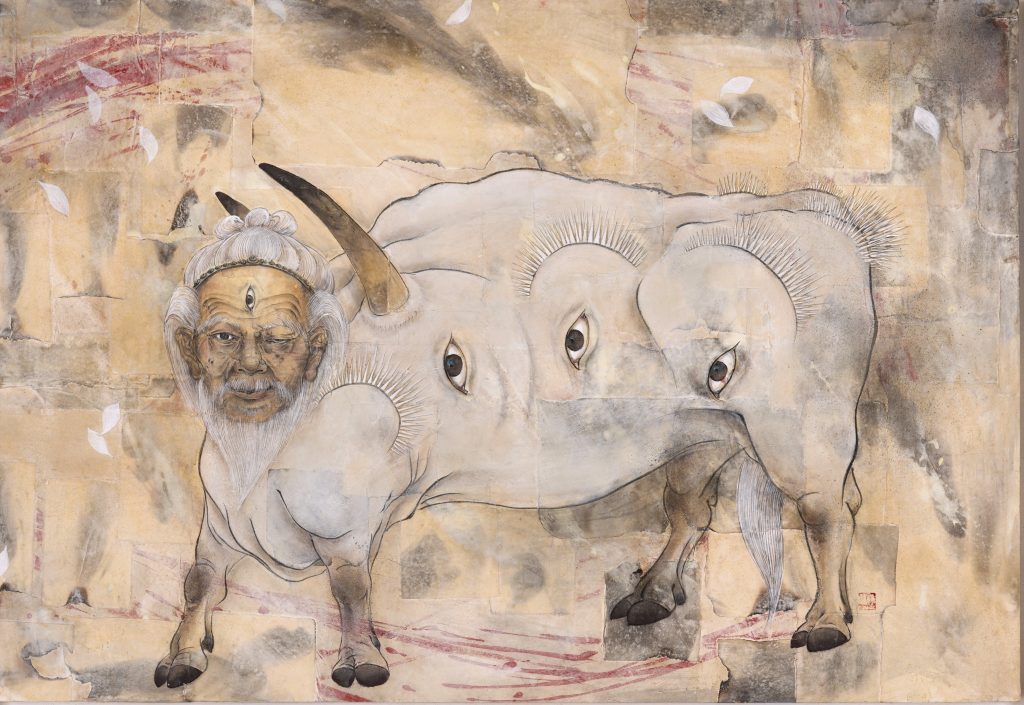
5.《白澤(はくたく)》 2002年 天然顔料、墨、膠、金箔、麻紙、蜜蠟 80.3×116.7㎝ 沖縄県立博物館・美術館蔵
5. HAKUTAKU, 2002, Natural pigment, Sumi ink, Glue, Gold leaf on Hemp paper, Beeswax, 80.3×116.7㎝, Collection of the Okinawa Prefectural Museum & Art Museum
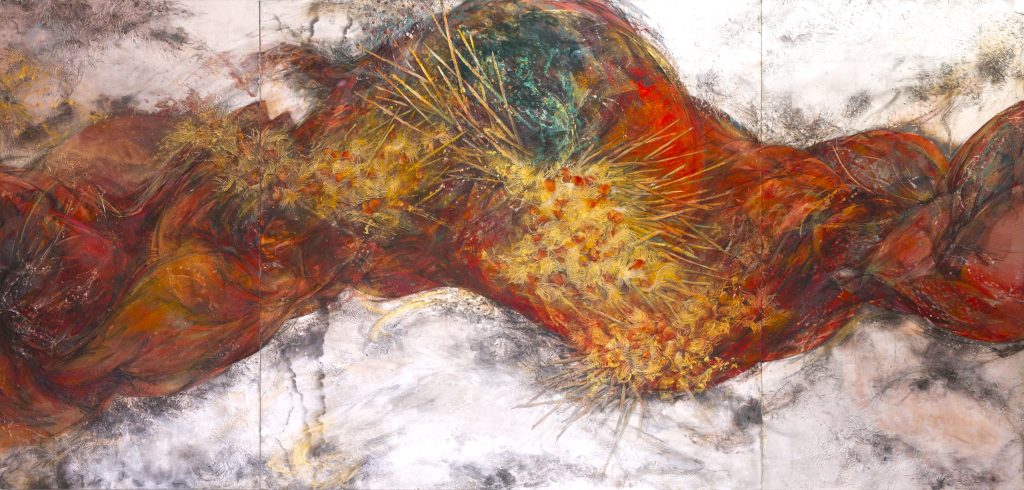
6.《胸中の華》 1994年 岩絵具、墨、膠、金銀箔、金銀泥、雲肌麻紙 194.0×410.0㎝ 個人蔵
6. Flower in My Mind, 1994, Pigment, Sumi ink, Glue, Gold and Silver leaf, Gold and Silver paint on Hemp paper, 194.0×410.0㎝ , Private collection

